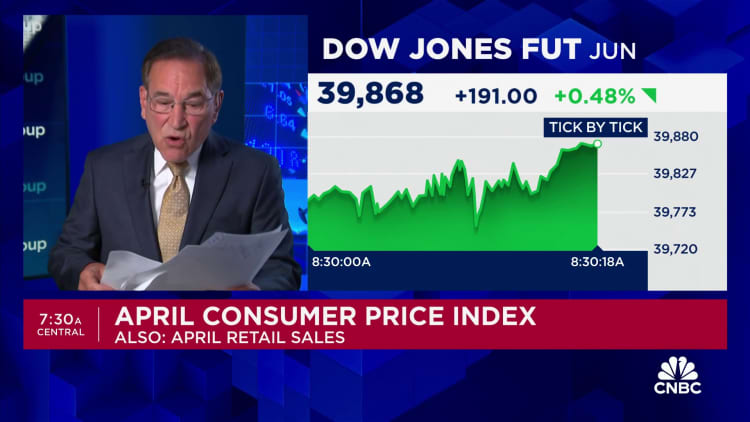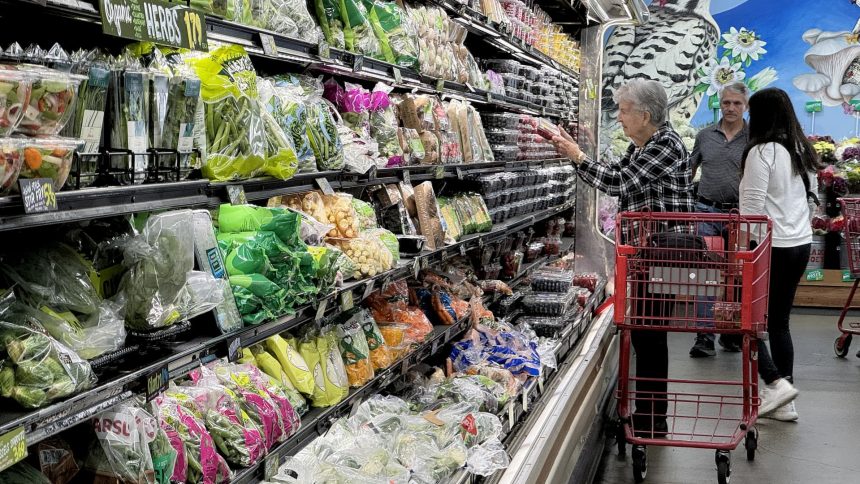Inflation fell slightly in April as easing price pressures for groceries and other areas of consumer balance sheets were partially offset by higher gasoline prices and stubbornly high housing costs.
The consumer price index, a key inflation gauge, rose 3.4% in April from a year ago, the U.S. Labor Department reported Wednesday. That’s down from 3.5% in March.
The report “is consistent with inflation, while still uncomfortably high, slowly coming back to earth,” said Mark Zandi, chief economist at Moody’s Analytics.
The CPI gauges how fast prices are changing across the U.S. economy. It measures everything from fruits and vegetables to haircuts, concert tickets and household appliances.
The April inflation reading is down significantly from its 9.1% pandemic-era peak in 2022, which was the highest level since 1981. However, it remains above policymakers’ long-term target, around 2%.
The decrease in April marks progress in the inflationary fight, which had somewhat flatlined in the first quarter of the year after falling consistently through much of 2023.
The inflation trend line will determine how soon Federal Reserve officials start throttling back interest rates, which influence borrowing costs for consumers and businesses.
“After getting stuck at the beginning of the year, we’re starting to see [inflation] moderate again,” Zandi said. “And I expect to see that going forward.”
Food inflation has ‘basically gone to zero’
Gasoline prices increased 2.8% in the month from March to April, a rise from 1.7% the prior month, the Bureau of Labor Statistics said.
“You saw prices at the pump rise again in April,” said Michael Pugliese, a senior economist at Wells Fargo Economics.
Average U.S. gasoline prices jumped about 13 cents in April, to $3.65 a gallon as of April 29, according to weekly data published by the U.S. Energy Information Administration.
That increase is largely due to dynamics in the market for crude oil, which is refined into gasoline, economists said. Higher fuel prices can filter through to many other areas of the economy since they factor into transportation and distribution costs for goods, for example.
Gas prices have since retreated a bit to $3.61 per gallon as of May 13, according to the EIA.
Among other consumer staples, grocery prices decreased by 0.2% from March to April, meaning they deflated rather than inflated, according to the CPI data. “Food at home” prices rose 1.1% in the past year.
“Food inflation has basically gone to zero,” Zandi said. “I think that’s really important for most American families, not only for their own financial situation but because of how they perceive the economy.”
Progress on housing has been slow
Economists generally like to consider an inflation measure that strips out energy and food prices, which can be volatile, to determine prevailing inflation trends. That reading, known as the “core” CPI, fell to an annual 3.6% in April from 3.8% in March.
Shelter, the largest spending category for the average household, is by far the biggest component of the “core” CPI. Annual housing inflation declined to 5.5% in April from 5.7% in March.
More from Personal Finance:
GameStop, AMC rallies like ‘watching a sitcom on repeat’
Education Dept. announces highest federal student loan interest rate in over a decade
Biden, Trump face ‘massive tax cliff’ amid budget deficit
Positive data trends like moderating prices for newly signed rental leases suggest housing inflation should continue to ease, economists said. However, that process hasn’t happened as quickly as expected.
“It’s one of the reasons we’ve seen slow progress” in the inflation fight, said Stephen Brown, deputy chief North America economist at Capital Economics.
Shelter and gasoline inflation combined contributed more than 70% of the monthly CPI increase for all items, according to the BLS.
Other “notable” areas in core inflation over the past year include motor vehicle insurance (prices are up 22.6%), personal care (3.7%), medical care (2.6%) and recreation (1.5%).
Meanwhile, other consumer categories have seen improvement.
For example, prices for new and used vehicles decreased 0.4% and 6.9% in the past year, respectively. Those lower costs should filter through to help motor vehicle insurance inflation fall, too, economists said.
Supply and demand imbalances
At a high level, imbalances in supply and demand are what trigger out-of-whack inflation.
For example, the Covid-19 pandemic disrupted supply chains for goods. Americans’ buying patterns also simultaneously shifted away from services — such as entertainment and travel — toward physical goods since they stayed at home more, driving up demand and fueling decades-high goods inflation.
Those dynamics have largely unwound, economists said. Rather, inflation is now “more of a services story than it is a goods story,” Pugliese said.
Wage growth has been one contributor to services inflation, for example, economists said.

The services sector of the U.S. economy tends to be more sensitive to labor costs. Record-high demand for workers as the pandemic-era economy reopened pushed wage growth to its highest level in decades; the labor market has since cooled and wage growth has declined, though remains above its pre-pandemic level.
“Until we observe meaningful signs of deterioration in either the labor or housing markets, we expect continued stickiness in inflation measures,” Joe Davis, global chief economist at Vanguard, wrote Tuesday.
Wage growth has surpassed the inflation rate over the last year, meaning consumers have been able to buy more with their paychecks. So-called real average hourly earnings rose 0.5% from April 2023 to April 2024.
Don’t miss these exclusives from CNBC PRO
Read the full article here




